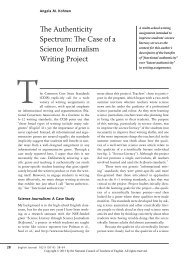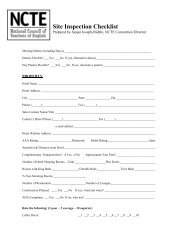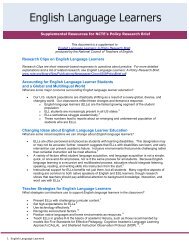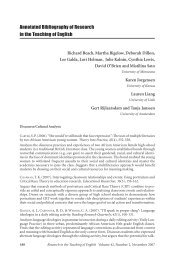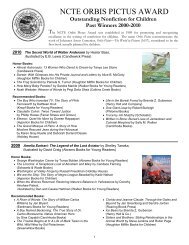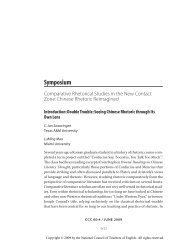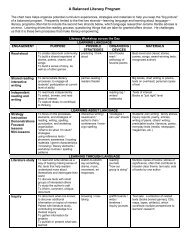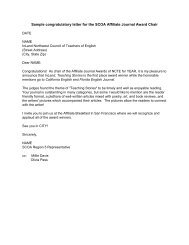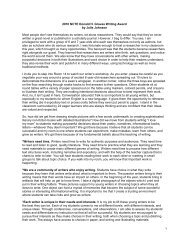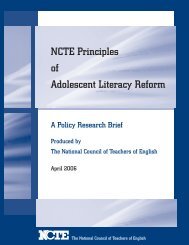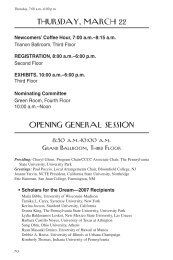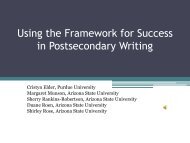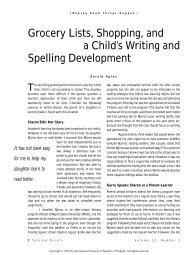<strong>Annotated</strong> <strong>Bibliography</strong> 221multiple opportunities for review. Study 2 f<strong>in</strong>ds that a greater number <strong>of</strong> words were learnedand attributes this to added reviews and <strong>the</strong> <strong>in</strong>struction <strong>of</strong> word mean<strong>in</strong>gs.BOWYER-CRANE, C., & SNOWLING, M. J. (2005). Assess<strong>in</strong>g children’s <strong>in</strong>ference generation: What dotests <strong>of</strong> read<strong>in</strong>g comprehension measure? British Journal <strong>of</strong> Educational Psychology, 75(2), 189-201.Exam<strong>in</strong>es whe<strong>the</strong>r poor comprehenders have comprehension difficulties <strong>in</strong> general, or problemswith mak<strong>in</strong>g particular types <strong>of</strong> <strong>in</strong>ferences. Analyzes <strong>the</strong> performance <strong>of</strong> 10 poor and 10normal n<strong>in</strong>e-year-old readers on two read<strong>in</strong>g comprehension tests. F<strong>in</strong>ds that poorcomprehenders were able to make cohesive <strong>in</strong>ferences, but performed poorly on generat<strong>in</strong>gknowledge-based and elaborative <strong>in</strong>ferences. Concludes that poor comprehenders would benefitfrom support <strong>in</strong> <strong>the</strong> use <strong>of</strong> real-world knowledge to generate <strong>in</strong>ferences dur<strong>in</strong>g read<strong>in</strong>g.BRITTO, P. R., BROOKS-GUNN, G., & GRIFFIN, T. M. (2006). Maternal read<strong>in</strong>g and teach<strong>in</strong>g patterns:Associations with school read<strong>in</strong>ess <strong>in</strong> low-<strong>in</strong>come African American families. Read<strong>in</strong>g <strong>Research</strong>Quarterly, 41(1), 68-89.Investigates <strong>the</strong> teach<strong>in</strong>g patterns and levels <strong>of</strong> support displayed by young African Americanmo<strong>the</strong>rs while <strong>in</strong>teract<strong>in</strong>g with <strong>the</strong>ir preschool-aged children <strong>in</strong> <strong>the</strong>ir homes. Mo<strong>the</strong>r-child <strong>in</strong>teractionswere videotaped, coded, and later categorized <strong>in</strong>to two styles (story readers and storytellers) and three teach<strong>in</strong>g patterns (low support and low teach<strong>in</strong>g; support and low teach<strong>in</strong>g;support and teach<strong>in</strong>g). F<strong>in</strong>ds that children’s vocabulary and school read<strong>in</strong>ess are improved when<strong>the</strong>y are exposed to a more <strong>in</strong>teractive and supportive maternal teach<strong>in</strong>g pattern.CARLISLE, J. F., & STONE, C. A. (2005). Explor<strong>in</strong>g <strong>the</strong> role <strong>of</strong> morphemes <strong>in</strong> word read<strong>in</strong>g. Read<strong>in</strong>g<strong>Research</strong> Quarterly, 40(4), 428-449.Investigates <strong>the</strong> role <strong>of</strong> morphemic structure on students’ word-read<strong>in</strong>g skills through two studies.The first study analyzed 2nd through 3rd grade and 5th through 6th grade students’ read<strong>in</strong>g <strong>of</strong>words that conta<strong>in</strong> a base word plus affix, versus a similar word with only one morpheme (e.g.,hilly versus silly). The second study compared middle and high school students’ read<strong>in</strong>g <strong>of</strong>derived words that were phonologically transparent (e.g., security) versus derived words with asound shift (e.g., precision). F<strong>in</strong>ds that morphemic structure plays a role <strong>in</strong> read<strong>in</strong>g derivedwords: students read derived words more quickly and accurately than similar words that conta<strong>in</strong>edonly one morpheme. At <strong>the</strong> secondary level, students more quickly and accurately readphonologically transparent derived words. Emphasizes <strong>the</strong> need to <strong>in</strong>clude morphemic analysis<strong>in</strong> models <strong>of</strong> word-read<strong>in</strong>g development.EDMUNDS, K. E., & BAUSERMAN, K. L. (2006). What teachers can learn about read<strong>in</strong>g motivationthrough conversations with children. The Read<strong>in</strong>g Teacher, 59(5), 414-424.Exam<strong>in</strong>es <strong>the</strong> read<strong>in</strong>g motivation <strong>of</strong> 4th grade students by <strong>in</strong>terview<strong>in</strong>g a random sample <strong>of</strong>students from various achievement levels and levels <strong>of</strong> motivation (as perceived by <strong>the</strong>ir teachers).F<strong>in</strong>ds that students are motivated to read narrative texts that connect to <strong>the</strong>ir personal<strong>in</strong>terests, that have specific characteristics such as be<strong>in</strong>g “funny,” and that <strong>the</strong>y are allowed tochoose <strong>the</strong>mselves. Factors that contributed to motivation for expository texts <strong>in</strong>clude <strong>the</strong> knowledgestudents ga<strong>in</strong>, as well as personal <strong>in</strong>terest and choice. Students described be<strong>in</strong>g motivatedto read by family members, teachers, and <strong>the</strong>ir own <strong>in</strong>tr<strong>in</strong>sic motivation. Children <strong>in</strong> <strong>the</strong> studyfrequently mentioned peers as <strong>in</strong>fluenc<strong>in</strong>g what books to select and be<strong>in</strong>g motivated to read<strong>the</strong>m.GEHSMANN, K. M., & WOODSIDE-JIRON, H. (2005). Becom<strong>in</strong>g more effective <strong>in</strong> <strong>the</strong> age <strong>of</strong> accountability:A high-poverty school narrows <strong>the</strong> literacy achievement gap. In B. Maloch, J. V. H<strong>of</strong>fman,D. L. Schallert, C. M. Fairbanks, & J. Worthy (Eds.), The 54th yearbook <strong>of</strong> <strong>the</strong> national read<strong>in</strong>gconference (pp. 182-197). Oak Creek, WI: The National Read<strong>in</strong>g Conference.
222 <strong>Research</strong> <strong>in</strong> <strong>the</strong> Teach<strong>in</strong>g <strong>of</strong> <strong>English</strong> Volume 41 November 2006Reports <strong>the</strong> f<strong>in</strong>d<strong>in</strong>gs <strong>of</strong> one high-poverty elementary school’s change process as it moved froma rat<strong>in</strong>g <strong>of</strong> under-perform<strong>in</strong>g to mov<strong>in</strong>g <strong>of</strong>f <strong>of</strong> this list four years later. Focuses on <strong>the</strong> criticalelements <strong>of</strong> change required each year <strong>in</strong> <strong>the</strong> process, <strong>in</strong>clud<strong>in</strong>g attention to context, coherence,coach<strong>in</strong>g, and compassion. F<strong>in</strong>d<strong>in</strong>gs <strong>in</strong>dicate that change requires a district commitment tostability <strong>in</strong> <strong>the</strong> teach<strong>in</strong>g force and staff <strong>of</strong> <strong>the</strong> school over multiple years to allow a committedstaff to work through multiple years <strong>of</strong> learn<strong>in</strong>g and work on core issues. Coherence also <strong>in</strong>volvesa staff commitment to a common literacy framework used to guide literacy teach<strong>in</strong>g,learn<strong>in</strong>g, and assessments, and high-quality pr<strong>of</strong>essional development that spans multiple years.Coach<strong>in</strong>g by pr<strong>of</strong>essionals and peers was critical to success as well as ongo<strong>in</strong>g observations andfeedback from <strong>the</strong> pr<strong>in</strong>cipal. Attention to understand<strong>in</strong>g <strong>the</strong> challenges fac<strong>in</strong>g parents and <strong>the</strong>irchildren <strong>in</strong> this context and develop<strong>in</strong>g compassion for <strong>the</strong>se <strong>in</strong>dividuals was also key to <strong>the</strong>school’s success.GUTHRIE, J. T., WIGFIELD, A., HUMENICK, N. M., PERENCEVICH, K. C., TABOADA, A., & BARBOSA, P.(2006). Influences <strong>of</strong> stimulat<strong>in</strong>g tasks on read<strong>in</strong>g motivation and comprehension. The Journal<strong>of</strong> Educational <strong>Research</strong>, 99(4), 232-245.Investigates <strong>the</strong> use <strong>of</strong> stimulat<strong>in</strong>g tasks to <strong>in</strong>crease students’ situational <strong>in</strong>terest, dur<strong>in</strong>g <strong>in</strong>tegratedread<strong>in</strong>g and science <strong>in</strong>struction <strong>in</strong> 3rd grade. Two classrooms provided a high number <strong>of</strong>stimulat<strong>in</strong>g tasks, while two o<strong>the</strong>r classrooms provided a low number <strong>of</strong> stimulat<strong>in</strong>g tasks relatedto read<strong>in</strong>g. F<strong>in</strong>ds that a number <strong>of</strong> stimulat<strong>in</strong>g tasks <strong>in</strong>creased students’ motivation, which<strong>in</strong> turn was associated with <strong>in</strong>creased read<strong>in</strong>g comprehension on a standardized test.HYONA, J., & NURMINEN, A. (2006). Do adult readers know how <strong>the</strong>y read? Evidence from eyemovementpatterns and verbal reports. British Journal <strong>of</strong> Psychology, 97(1), 31-50.Investigates <strong>in</strong>dividual differences <strong>in</strong> read<strong>in</strong>g styles, and <strong>the</strong> degree to which competent adultreaders are aware <strong>of</strong> <strong>the</strong>ir read<strong>in</strong>g style. Participants read a long expository text while <strong>the</strong>ir eyefixation patterns were registered. Awareness <strong>of</strong> read<strong>in</strong>g behavior was assessed by a questionnaire.Identifies three types <strong>of</strong> readers: fast l<strong>in</strong>ear readers, slow l<strong>in</strong>ear readers, and topic structureprocessors. Readers were aware <strong>of</strong> <strong>the</strong>ir read<strong>in</strong>g speed, look-back, and re-read<strong>in</strong>g behaviors.Look<strong>in</strong>g back correlated positively with success <strong>in</strong> recall<strong>in</strong>g <strong>the</strong> ma<strong>in</strong> po<strong>in</strong>ts <strong>of</strong> <strong>the</strong> text.Concludes that look-back behavior is an <strong>in</strong>dication <strong>of</strong> strategic read<strong>in</strong>g.KAME’ENUI, E. J., FUCHS, L., FRANCIS, D. J., GOOD, R. III, O’CONNOR, R. E., SIMMONS, D. C., ET AL.(2006). The adequacy <strong>of</strong> tools for assess<strong>in</strong>g read<strong>in</strong>g competence: A framework and review. Educational<strong>Research</strong>er, 35(4), 3-11.Describes <strong>the</strong> Read<strong>in</strong>g First Assessment Committee’s (RFAC) framework for gaug<strong>in</strong>g <strong>the</strong> adequacy<strong>of</strong> tools available to assess read<strong>in</strong>g measures used with students <strong>in</strong> grades K-3. This<strong>in</strong>formation is <strong>in</strong>tended to provide state and local educational agencies with <strong>in</strong>formation thatmight help <strong>in</strong> <strong>the</strong> selection <strong>of</strong> read<strong>in</strong>g assessment <strong>in</strong>struments. Applies <strong>the</strong> framework to asample <strong>of</strong> tests, describ<strong>in</strong>g <strong>the</strong> selection and cod<strong>in</strong>g system. Provides f<strong>in</strong>d<strong>in</strong>gs centered on <strong>the</strong>“trustworth<strong>in</strong>ess” <strong>of</strong> assessments available to practitioners. Indicates that if high and rigorousstandards were used to assess trustworth<strong>in</strong>ess, <strong>the</strong>n very few tests would meet <strong>the</strong> m<strong>in</strong>imalrequirements. Suggests that <strong>the</strong> test developers use <strong>the</strong> RFAC’s documents to improve <strong>the</strong>irwork, and school districts use <strong>the</strong>se methods <strong>in</strong> select<strong>in</strong>g assessments.KLEIFGEN, J. (2005). ISO 9002 as literacy practice: Cop<strong>in</strong>g with quality-control documents <strong>in</strong> ahigh-tech company. Read<strong>in</strong>g <strong>Research</strong> Quarterly, 40(4), 450-468.Reports part <strong>of</strong> a larger ethnographic study <strong>of</strong> language and work <strong>in</strong> a small circuit-board manufactur<strong>in</strong>gplant with a racially, ethnically, and l<strong>in</strong>guistically diverse work force. Studied <strong>the</strong> preparationand use <strong>of</strong> quality-control documents, embedded with<strong>in</strong> a sociocultural perspective onliteracy, and collected observational and <strong>in</strong>terview data over two time periods. Found that workteams generally organize accord<strong>in</strong>g to ethnol<strong>in</strong>guistic background and <strong>of</strong>ten <strong>in</strong>voke local powerand agency <strong>in</strong> engag<strong>in</strong>g <strong>in</strong> quality-control documents.



